Strasbourg to Obenheim
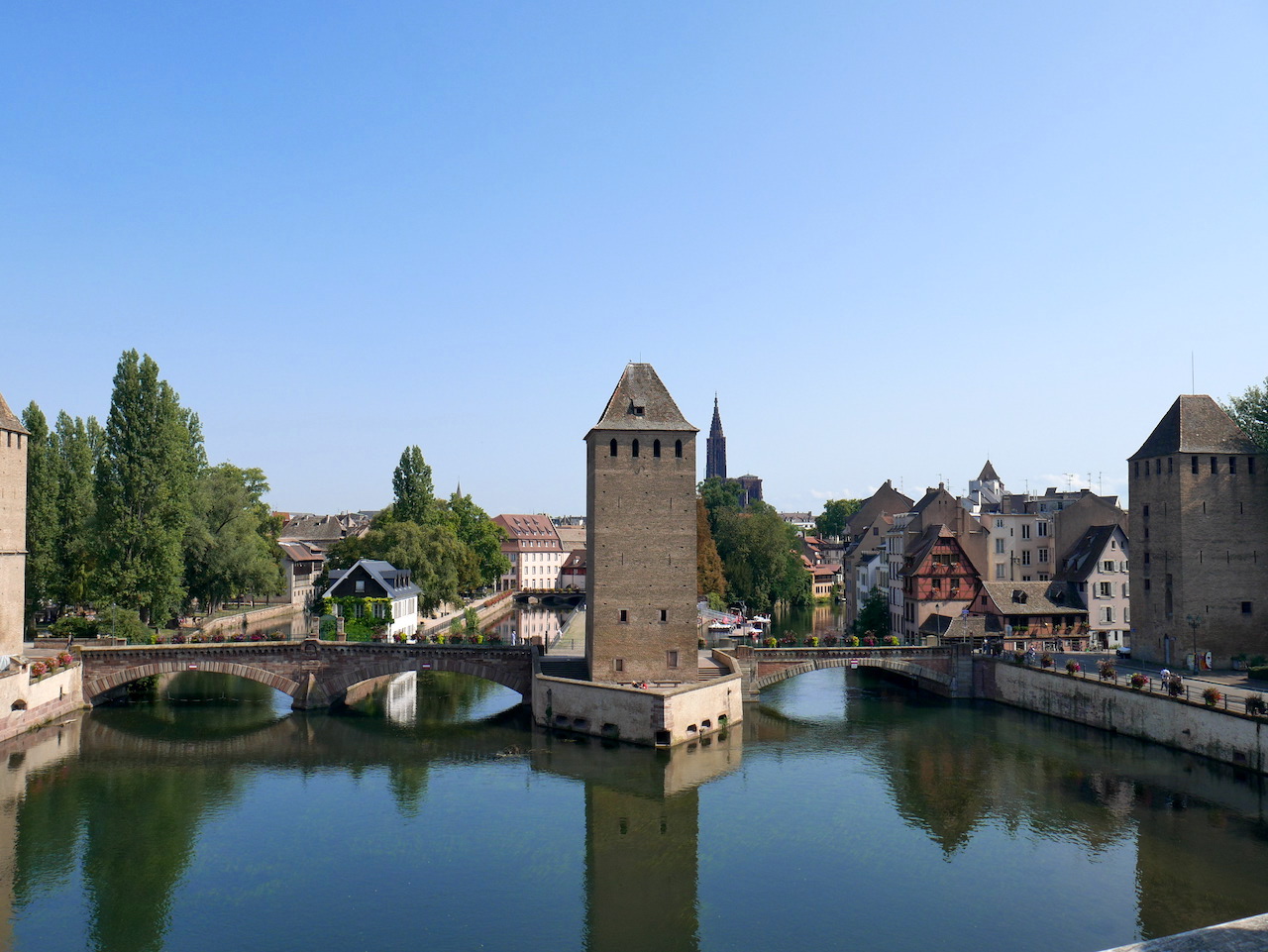
Grand Est
4. Strasbourg to Obenheim
Medium
7h30
27,9km
+147m
-148m
Step
Embed this item to access it offline
Starting from Strasbourg Cathedral, you will pass through a historic district and then follow an industrial zone to leave the Strasbourg conurbation. You can take a break at Fort Ulrich, after Illkirch-Graffenstaden, a few hundred meters from the Via Columbani. Cultivated fields and forests will alternate during your day.
9 points of interest

Bas-côté sud de la cathédrale Notre-Dame à Strasbourg - Amis de saint Colomban HistoricalThis "prodigy of the gigantic and the delicate", admired by Victor Hugo and celebrated by Goethe, who had his first love there, can be seen from very far away in the plain of Alsace, and even from the Vosges or the Black Forest.
Notre-Dame Cathedral was founded in 1015 on the remains of a previous cathedral and was erected from 1220 onwards by the Free City of Strasbourg, a rich merchant and financial republic, in the Gothic style.
142 metres high, it was for a long time the highest building in the world. Practically completed in 1365, it has the particularity of having seen the space between its two towers filled in in 1388 and can be recognized by its unique bell tower, topped by a spire added in 1439.
The site of the cathedral was used by several successive religious buildings from the time of the Roman occupation. According to tradition, a Roman sanctuary dedicated to the god Mars occupied the site until an unknown date. A cathedral was erected by Bishop Arbogast at the end of the 7th century on the basis of a temple dedicated to the Blessed Virgin, but no remains have been preserved until today. Piles from the foundation of the building in 1015 were found in 1905. After the fire of 1176, which destroyed the eastern parts of the cathedral, Henri d'Asuel dit Hasenbourg, the new bishop of Strasbourg from 1180 to 1190, decided to build a fourth cathedral. At the end of 1276, Bishop Conrad de Lichtenberg ordered the construction of the Western Massif, which was completed in 1439.
More information: Wikipedia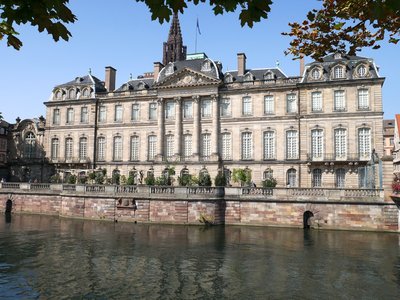
Palais Rohan à Strasbourg, 18e siècle - Les Amis de saint Colomban HistoricalPalais Rohan in Strasbourg
Residence of the Bishop of Strasbourg in the 18th century. The palace was built between 1732 and 1741 for Cardinal Armand-Gaston de Rohan-Soubise, prince bishop of Strasbourg, and was inspired by the great mansions of Paris. During the Revolution it became the town hall and from 1805 onwards an imperial and royal residence. Seat of the German university from 1872 to 1884, it now houses an archaeology museum, a museum of decorative arts and a museum of fine arts.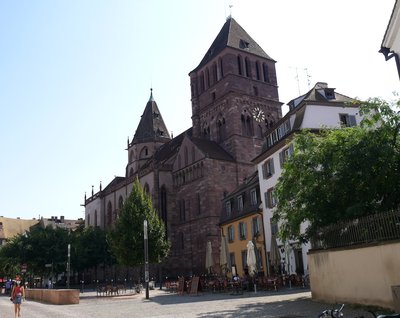
Église protestante Saint-Thomas à Strasbourg - Les Amis de saint Colomban HistoricalChurch St Thomas Strasbourg
It is the only Protestant church to have preserved canons and a Protestant seminary is located nearby.
St. Thomas' Church has a very special architectural type as it is a five-ship hall church of equal height. It is the oldest in the southwestern part of the Holy Roman Empire, thus contradicting the usual basilica design. The church is surmounted by two bell towers: a square one at the main entrance and a hexagonal one at the transept crossing.
Since the 6th century, the building has been known as Saint-Thomas and the bishop Saint-Florent of Strasbourg was buried there around 697.
Saint-Florent was an Irish hermit who lived at the foot of the Ringelsberg near Schirmeck, with a few cells the monastery of the Holy Trinity was born, it is there that he was picked up to be bishop. He had a hospice built near St. Thomas Church to accommodate his Irish companions. At the beginning of the Middle Ages, his tomb in St. Thomas Church became a place of pilgrimage for Irish monks.
More info at: Wikipedia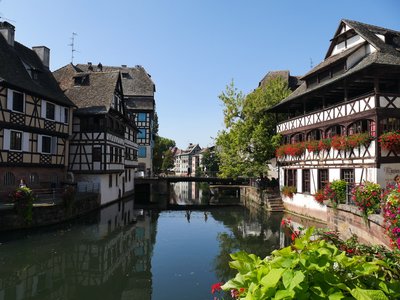
La Petite France à Strasbourg au bord de l’Ill. - Les Amis de saint Colomban TouristLa Petite France in Strasbourg
A charming district of Strasbourg that you will pass through at the start of your stage. The river Ill, made navigable before flowing into the Rhine, came to crack near the half-timbered houses so characteristic of Alsace. Do not hesitate to discover these very picturesque lanes before taking the Via Columbani and crossing the Covered Bridges, which are no longer covered, with its towers and admire the Vauban dam. This district deserves several hours of visit.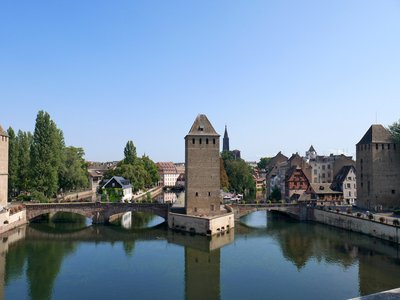
Les « Ponts Couverts » à Strasbourg - Les Amis de saint Colomban Historical"Covered Bridges" in Strasbourg
After the visit of Petite France you will discover the "Ponts Couverts". The cover was removed in the 18th century but the name has remained. The 4 towers of the 14th century give an imposing view of the former ramparts of the republic of Strasbourg in the Middle Ages.
After Strasbourg was attached to France in 1681, a new belt of fortifications was built by Vauban, of which the dam, which can be admired from the "Ponts Couverts", is one of the last remains.
L’église Saint-Trophime à Eschau 10e et 11e siècles - Les Amis de saint Colomban TouristChurch of St. Trophime in Eschau
Eschau, situated on the Roman road from Basel to Strasbourg, was for seven and a half centuries (770-1525) the seat of a community of Benedictine nuns, founded by the Bishop of Strasbourg Remigius around 770, nephew of St. Odile. According to Bishop Remi's will, written on 15 March 778, he brought back from Rome on 10 May 777 relics of Saint Sophia of Rome and those of her three daughters, received from Pope Adrian I. He placed them in the abbey church dedicated to Our Lady and Saint Trophime. The abbey was consecrated to Saint Sophia.
The nuns remained there until 1525. The abbey was then incorporated into the episcopal mense, and in 1615 it was ceded to the Grand Chapter of Strasbourg, which administered it until its destruction during the Revolution. All that remains of the abbey today is the Romanesque abbey church, restored at the end of the 10th century by Bishop Widerold, an important figure at the court of Otto 1, Emperor of the Holy Roman Empire.
This Romanesque construction is representative of Ottonian architecture, whose roots are in the imperial art of Charlemagne.
Legend has it that Saint Trophime was the first bishop of Arles.
More information: Wikipédia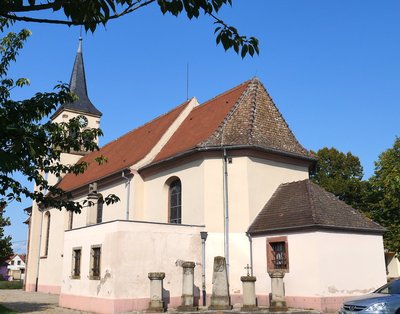
Église protestante à Plobsheim - Les Amis de saint Colomban TouristThe Protestant Church in Plobsheim
The village of Plobsheim, which lived from agriculture and fishing for a long time, has not preserved any ancient monuments from its rich Protestant past, although the Reformation was introduced here around 1555 by its lords, a branch of the Zorn. The main reason for this is that the church had become too small: 270 places for 1126 Protestant inhabitants in 1895. It had also been used for Catholic worship since 1684. It was then demolished and replaced by two larger buildings, one in neo-Romanesque style, on a Greek cross plan, for the Protestant parish (1898), the other for the Catholic parish. The church has Roethinger organs dating from 1898.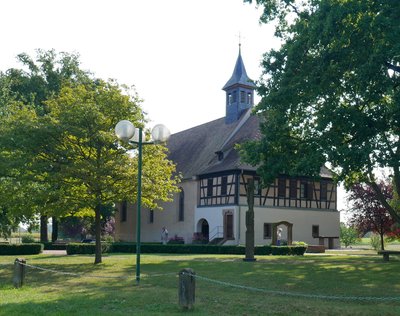
Chapelle Notre-Dame du Chêne à Plobsheim - Les Amis de saint Colomban HistoricalChapel of Our Lady of the Oak in Plobsheim
Chapel located on the east bank of the canal. The Via Columbani runs along the west bank, you can change banks from the M 222 bridge in Plobsheim.
In 1444, Adam Zorn, lord of Plobsheim, fights the Armagnacs and finds himself in trouble. He promises to build a chapel to Mary if he returns safe and sound. But once back, he forgets his promise. Legend has it that while hunting, he followed a dove and that the Virgin Mary appeared to him. He had the chapel built in an oak forest, an ancient druidic place of worship. The chapel, now classified as a historical monument, is remarkable for its polygonal choir with double cross ribs and for the small house adjoining it, the former residence of a hermit.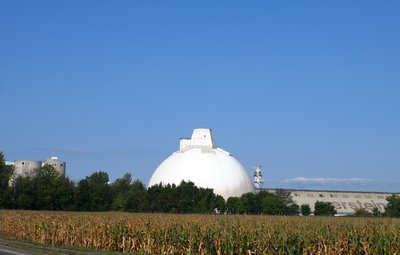
Sucrerie d’Erstein - Les Amis de saint Colomban HistoricalErstein's sweets
During your walk a big metal ball will catch your eye. It is one of the elements of Erstein's candy.
At the beginning of the 19th century, Alsace was the first French region to grow sugar beet and already had a number of sugar factories. The "Erstein Sugar Factory in Alsace" (Elsàssische Zuckerfabrik) was founded in 1893 by Hugo Zorn von Bülach, son of Baron François Zorn von Bülach, under-secretary of state for agriculture in France before 1870 and member of the Reichstag after the defeat of 1870.
The sugar refinery was able to continue its expansion after the War of 1870 and on its return to France in 1918.
In 2007, the sugar factory became part of a sugar cooperative consisting of several sugar factories in northern France and diversified into distillation products.
In April 2019, against a backdrop of the end of European sugar quotas leading to a drop in prices, the company announced a restructuring plan that would affect jobs at Erstein.
Description
Departure from the square in front of Strasbourg Cathedral in front of the facade on the right, rue du Maroquin, on the right in front of the river continue on the towpath along the river, after the Saint-Martin bridge, on the left cross the lock, follow the edge of the lock and then the bank of the river Ill channeled.
- Left on the Covered Bridges, right Place du Quartier Blanc stay on the edge of the Vauban basin and the Ill river, after the Louis Pasteur bridge take the footbridge on the left to cross the canal, follow the canal on the cycle path quai Jean-Pierre Mayno, rue du Doubs, rue de la Saône
- At the lock (n°84) change bank of the canal by taking the bridge of the rue du Muguet, pass the lock to come back to the edge of the lock to access the bridge, after the bridge cross the D 468 on the left to take the cycle path along the canal from Rhône to Rhine for 19 000 meters.
- After the lock of Gerstheim, take the second bridge on the left on D 924 towards Gerstheim, rue de Sand, on the right on D 468 towards Obenheim, rue de Strasbourg, on the right rue Voegele you arrive at the church Saint-Rémi.
- Departure : Notre Dame Cathedral, Cathedral Square, Strasbourg
- Arrival : Saint-Rémi Church, 9 rue Voegelé, 67 230 Obenheim
- Towns crossed : Grand Est
Altimetric profile
Access and parking
Report a problem or an error
If you have found an error on this page or if you have noticed any problems during your hike, please report them to us here:







